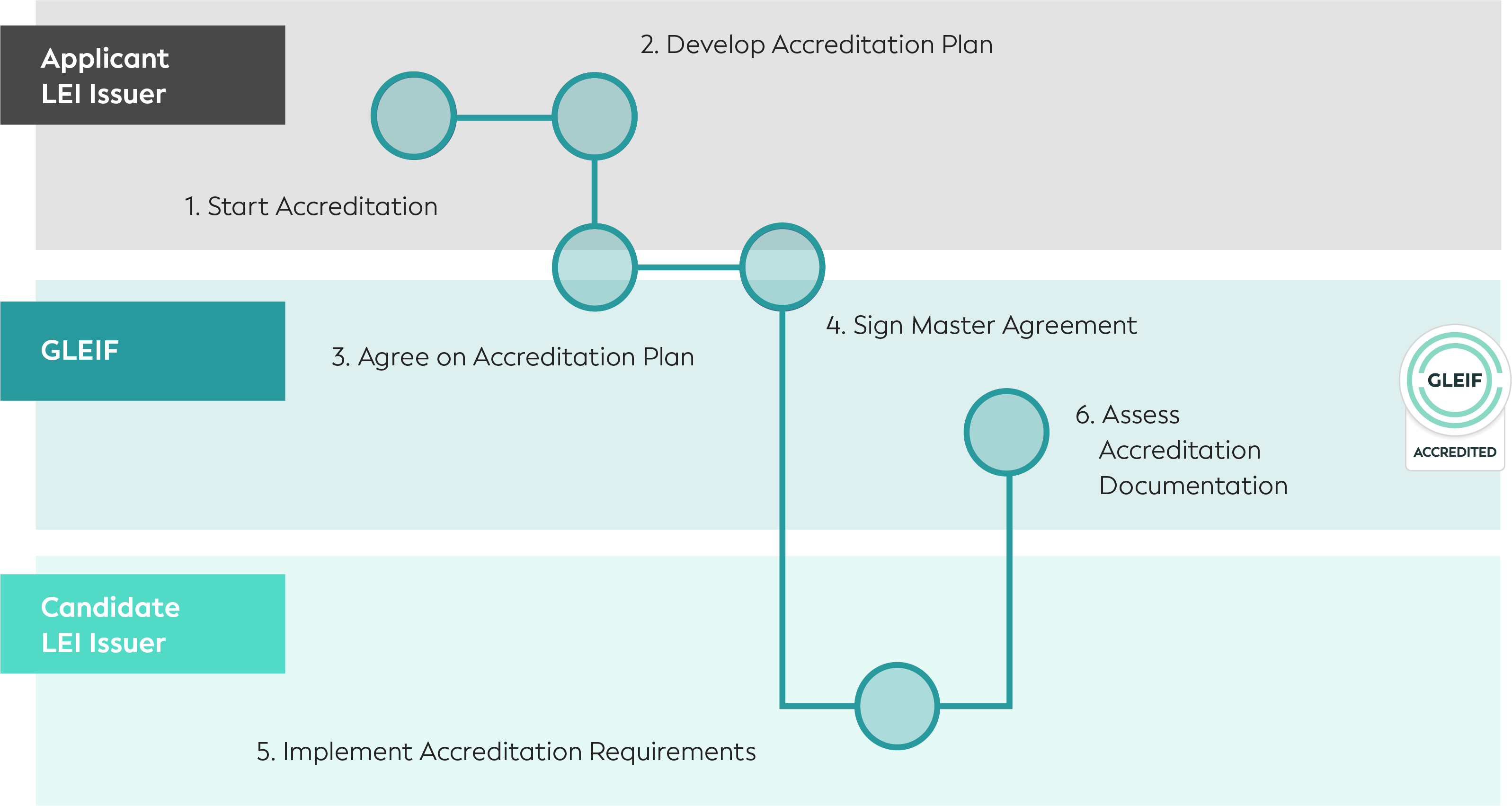Accreditation Process
The accreditation process established by the Global Legal Entity Identifier Foundation (GLEIF), which must be successfully completed by organizations seeking to become LEI issuers, is divided into two phases.
An organization authorized to issue LEIs to legal entities participating in financial transactions is referred to as a Local Operating Unit (LOU).
The first phase of the accreditation process requires the organization seeking to become an LEI issuer, i.e. the Applicant LOU, to create an accreditation plan. This should outline the goals, objectives and capabilities of the Applicant LOU, and how they fit within GLEIF’s operational and control environment. After review and approval by GLEIF, the Applicant LOU is required to sign the Master Agreement. This designates it a Candidate LOU and the second phase begins.
The second phase requires the Candidate LOU to submit the full accreditation documentation, as detailed in the Accreditation Checklist, to GLEIF for review within three months of signing the Master Agreement. GLEIF then has a review period of no longer than ninety business days to determine whether the Candidate LOU:
- Passes, receives its Accreditation Certificate and is allowed to commence offering LEI services, or
- Fails, has its Master Agreement terminated and is not allowed to offer LEI services, or
- Passes provisionally. In this case GLEIF provides an explanation of what authority the Candidate LOU now has with respect to offering LEI services and what it must do to receive the full Accreditation Certificate.
The requirements that must be met within the accreditation process are further described in the Accreditation Manual.
The diagram below demonstrates the six steps of the accreditation process. A summary of the actions related to each step is available within the text underneath the diagram.

- Step 1: Start Accreditation
- Your organization is considering an application to become a Global Legal Entity Identifier Foundation (GLEIF) accredited LEI issuer, i.e. a Local Operating Unit (LOU). The first step is to understand the role of GLEIF in the Global LEI System and the functions of a LOU.
- Step 2: Develop Accreditation Plan
- Every organization begins the process as an ’Applicant’ and prepares an accreditation plan for GLEIF review. The accreditation plan describes how your organization sees itself integrating into the Global LEI System and what type of services you are considering providing. You will submit your accreditation plan when you believe that it is complete and meets all the requirements described in the Accreditation Plan Checklist.
- Step 3: Agree on Accreditation Plan
- Your organization, working in partnership with GLEIF, will review your goals, objectives and business plan to ensure alignment with the Global LEI System and GLEIF operations. The accreditation plan is the high-level road map that communicates to GLEIF how your organization will participate in and benefit from the Global LEI System.
- Step 4: Sign Master Agreement
- Once your accreditation plan is approved, the Applicant and GLEIF will enter into the Master Agreement, a formal, binding contract defining the obligations of both parties: GLEIF, in its oversight and support role and your organization with respect to providing LEI services as a LOU.
- Step 5: Implement Accreditation Requirements
- Your organization, which is now referred to as a ‘Candidate’, will prepare the Accreditation Checklist. The Accreditation Checklist is available on our website – please ensure you use the most current version of the Checklist in your submission.
The Checklist is a detailed questionnaire, which focuses on your internal controls and understanding of the operational practice requirements of a LOU. This is likely the most time consuming part of the accreditation process, since your responses will often require additional supporting documentation to fully explain your answers. You have up to six calendar months from the signing of the Master Agreement to submit a complete set of documentation. - Step 6: Assess Accreditation Documentation
- Based upon the agreed timetable, GLEIF will review the completed accreditation documentation and assess the level of compliance with expected standards. In some cases, additional information may be requested. GLEIF may take up to ninety business days to complete its assessment depending on resource demands.
You will receive feedback on your application and may be asked for additional information where necessary. You will be advised of the final decision of the GLEIF Board of Directors. Successful completion results in GLEIF accreditation and authorization to begin issuing LEIs to legal entities in authorized jurisdictions.
GLEIF accreditation confirms that the LOU meets or exceeds the GLEIF quality and performance standards based upon the materials presented and testing performed; the Master Agreement requires the LOU to maintain these quality standards every operating year for an initial three year term.
